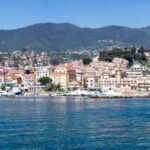Italy is known for its rich history, vibrant culture, and breathtaking scenery, making it a top destination for travelers from around the world. However, in order to ensure the safety and security of their citizens while abroad, many governments issue travel advisories and risk ratings for different countries. This article explores why Italy has been given a 2 on the State Travel Risk Rating system and what this rating means for travelers.
The State Travel Risk Rating system is a scale used by governments to indicate the level of risk associated with traveling to a specific country. Ratings range from 1 (exercise normal precautions) to 4 (do not travel).
Italy’s rating of 2 suggests that there are some potential risks involved but they are relatively low when compared to countries with higher ratings. Understanding the reasons behind this rating can help travelers make informed decisions about whether or not to visit Italy.
In this article, we will delve into the various factors that contribute to Italy’s current State Travel Risk Rating of 2. We will examine its historical and cultural significance as a tourist destination, its efficient healthcare system, low crime rates, comprehensive transportation network, strong economy and infrastructure, as well as the government’s dedication to ensuring tourist safety and security. Additionally, we will explore Italy’s well-established tourism industry and experience in catering to international visitors.
By understanding these key aspects of Italy’s travel risk rating, readers will be able to gain insights into why Italy is considered a relatively safe country for travel. It is important to note that while a rating of 2 signifies a lower level of risk compared to other countries, it is still essential for travelers to exercise caution and follow any advisories or guidelines provided by their own government or international organizations during their trip to Italy.
Brief Overview of Italy’s Current State Travel Risk Rating
Italy is currently rated as a 2 on the State Travel Risk Rating system. This rating indicates that Italy has a low-risk level for travel and is generally considered safe for tourists. The 2 rating takes into account various factors such as the country’s healthcare system, crime rates, transportation network, economy, infrastructure, government dedication to tourist safety, and experience in catering to international visitors.
Italy’s historical and cultural significance make it an attractive destination for travelers from around the world. From ancient ruins in Rome to beautiful Renaissance art in Florence and canals of Venice, Italy offers a rich tapestry of history and culture. With an impressive number of UNESCO World Heritage Sites scattered throughout the country, tourists have plenty to explore and appreciate.
In terms of healthcare, Italy boasts an efficient and advanced healthcare system. The country has a robust network of hospitals and medical facilities that provide quality care to residents as well as tourists. This ensures that visitors have access to medical assistance should they require it during their stay.
Additionally, Italy has consistently low crime rates across the country. This provides peace of mind for travelers as they can explore popular tourist attractions and wander through charming streets without worrying about their safety. The well-established law enforcement agencies in Italy contribute greatly to maintaining this safe environment for tourists.
Furthermore, Italy offers a comprehensive transportation network that makes travel easy and accessible. The country has an extensive railway system that connects major cities allowing visitors to conveniently navigate through different regions. In addition, Italy’s efficient public transportation systems including buses and trams provide convenient options for exploring within cities.
Italy’s strong economy and infrastructure also ensure stability for tourism. The country has well-developed tourist facilities such as hotels, restaurants, and shopping centers that meet international standards. Furthermore, Italy’s investment in preserving historical sites demonstrates its commitment to maintaining its rich cultural heritage while providing modern amenities for tourism.
The Italian government is dedicated to ensuring the safety and security of tourists. They have implemented policies to protect visitors and promote a safe environment throughout the country. Tourist police forces are present in popular tourist areas to assist travelers and ensure their safety.
Lastly, Italy has a well-established tourism industry with years of experience in catering to international visitors. The hospitality sector in Italy is highly skilled at offering excellent service and creating memorable experiences for tourists. The combination of warm Italian hospitality, cultural richness, and commitment to safety has made Italy a popular choice among travelers worldwide.
Historical and Cultural Significance of Italy as a Tourist Destination
Italy has long been renowned for its rich historical and cultural heritage, making it a top tourist destination worldwide. From the ancient ruins of Rome to the Renaissance art in Florence and the picturesque canals of Venice, Italy offers a diverse range of attractions that appeal to travelers of all interests. The historical and cultural significance of Italy not only adds to the country’s charm but also contributes to its popularity as a tourist destination.
One of the main draws for tourists visiting Italy is its wealth of historical sites. Italy is home to some of the most iconic landmarks in the world, such as the Colosseum, the Roman Forum, and Pompeii. These ancient ruins allow visitors to delve into the past and witness firsthand the grandeur and achievements of early civilizations.
In addition to ancient history, Italy is also renowned for its contributions to art and culture. Cities like Florence are home to world-class museums that house priceless works by legendary artists such as Leonardo da Vinci, Michelangelo, and Botticelli.
Italy’s cultural significance is also evident in its rich culinary traditions. Italian cuisine has become a global phenomenon, with dishes like pasta, pizza, gelato, and espresso being enjoyed worldwide. Food plays an integral role in Italian culture, and travelers have the opportunity to indulge in authentic flavors while savoring local specialties in charming trattorias or bustling street markets.
Furthermore, Italy’s festivals and celebrations showcase its vibrant cultural tapestry. From Carnivale in Venice with its elegant masks and costumes to Siena’s Palio horse race extravaganza and the colorful infiorata flower festivals held throughout the country, these events provide visitors with unique insights into Italian traditions.
Italy’s Efficient and Advanced Healthcare System
Italy is known for its efficient and advanced healthcare system, which plays a significant role in ensuring the safety and well-being of travelers. The country’s commitment to providing quality healthcare services has contributed to its 2-state travel risk rating. Italy boasts a comprehensive healthcare system that offers excellent medical facilities, highly trained healthcare professionals, and advanced technology.
One of the key factors that sets Italy’s healthcare system apart is its universal coverage. The Italian National Health Service (SSN) provides healthcare services to all residents and citizens, including tourists who may require medical assistance during their visit. This ensures that travelers have access to affordable and high-quality medical care, reducing any concerns about potential health risks while visiting the country.
Furthermore, Italy is home to several world-renowned hospitals and medical research centers. With state-of-the-art equipment and cutting-edge research, these institutions attract top medical professionals from around the globe. This expertise translates into excellent patient care for both residents and visitors alike.
In addition to its strong healthcare infrastructure, Italy also has a robust emergency response system. The Italian emergency number is 112, which connects callers to police, fire departments, ambulance services, or any other necessary emergency response team. This ensures that help is readily available in case of any unexpected medical situations or emergencies.
Overall, Italy’s efficient and advanced healthcare system gives tourists peace of mind knowing that they will receive prompt and high-quality medical care if needed during their visit. This dedication to providing excellent healthcare services contributes to Italy’s low state travel risk rating.
| Key Points | Data |
|---|---|
| Universal coverage | Italian National Health Service (SSN) provides healthcare services to all residents and citizens |
| World-renowned hospitals and medical research centers | Italy is home to several institutions with state-of-the-art equipment and top medical professionals |
| Robust emergency response system | The Italian emergency number is 112, ensuring prompt assistance in case of emergencies |
Low Crime Rates Across Italy, Ensuring Safety for Travelers
Italy is known for its low crime rates, which ensures the safety and security of travelers visiting the country. This aspect has contributed to Italy’s 2-state travel risk rating. With a strong emphasis on public safety, the Italian government and law enforcement agencies have implemented various measures to maintain a safe environment for both locals and tourists.
Efficient Law Enforcement Agencies
Italy has efficient law enforcement agencies that work tirelessly to maintain public safety throughout the country. The Carabinieri, Italy’s national military police force, plays a crucial role in combating crime and ensuring the safety of citizens and visitors alike. Their presence can be seen across major tourist destinations, providing visible security and reassurance to travelers.
Strict Laws and Regulations
Italian laws are well-enforced to deter criminal activities and maintain order. Strict penalties are imposed for offenses such as theft, assault, and fraud, ensuring a sense of security for tourists. The Italian justice system is known for its fairness and efficiency in addressing criminal cases, further contributing to the overall safety of foreigners visiting the country.
Tourist Police Units
To cater specifically to the needs of tourists and ensure their safety, Italy has established dedicated tourist police units in major cities such as Rome, Florence, Venice, and Milan. These units consist of specially trained officers who are fluent in multiple languages and are familiar with the specific concerns that international visitors may have. They provide assistance, guidance, and support to tourists while also maintaining law and order.
Comprehensive Transportation Network in Italy, Making Travel Easy and Accessible
Italy is known for its comprehensive transportation network, which makes travel within the country easy and accessible for both locals and tourists. The transportation infrastructure in Italy includes an extensive road network, well-connected airports, reliable train services, and a variety of public transportation options.
One key aspect of Italy’s transportation system is its road network. The country has a well-developed system of highways and roads that connect major cities and towns across the country. This makes it convenient for travelers to explore different regions of Italy by car or by hiring private transportation services. Additionally, Italy’s scenic countryside makes road trips a popular choice among tourists who want to experience the beauty of the landscape at their own pace.
Another important mode of transportation in Italy is its train service. The Italian railway system, operated by Trenitalia, offers efficient and comfortable train journeys throughout the country. High-speed trains such as the Frecciarossa and Frecciargento connect major cities like Rome, Milan, Florence, and Venice with shorter travel times. Regional trains provide access to smaller towns and villages, offering travelers an opportunity to explore off-the-beaten-path destinations.
Italy also has a reliable network of airports that provide domestic and international flights. Major cities like Rome, Milan, Naples, Florence, and Venice have international airports with direct flights from various countries around the world. This allows tourists to easily reach Italy from different parts of the globe.
To enhance accessibility within cities and towns, Italy offers an array of public transportation options including buses, trams, metros (subways), and even water taxis in certain coastal areas like Venice. These modes of transport are not only efficient but also affordable compared to private transport options.
| Transportation Mode | Description |
|---|---|
| Roads | An extensive highway and road network connecting major cities and towns across the country. |
| Trains | An efficient and comfortable train service operated by Trenitalia, including high-speed trains (Frecciarossa and Frecciargento) for quick travel between major cities. |
| Airports | Well-connected international airports in major cities with direct flights from various countries. |
| Public Transportation | Buses, trams, metros (subways), and water taxis available within cities and towns for convenient travel. |
Italy’s Strong Economy and Infrastructure, Ensuring Stability for Tourism
One of the key reasons why Italy is ranked as a 2 on the state travel risk rating is its strong economy and infrastructure, which ensures stability for tourism. Italy has long been known for its economic prowess and stable financial system. The country boasts the eighth-largest economy in the world and is a member of the G7, further solidifying its position as a global economic powerhouse.
Italy’s strong economy translates into a robust infrastructure that supports the tourism industry. The country has invested heavily in developing and maintaining its transportation networks, including an extensive railway system, well-maintained roads, and modern airports. This infrastructure allows for easy access to various tourist destinations across the country, making it convenient for travelers to explore all that Italy has to offer.
Furthermore, Italy’s strong economy also plays a significant role in ensuring stability for tourists. A stable economy means that there is less likelihood of political instability or economic crises that can disrupt travel plans. Moreover, a thriving economy provides a solid foundation for businesses within the tourism sector to flourish. Hotels, restaurants, tour operators, and other related industries benefit from a stable business environment, which ultimately enhances the overall tourism follow noopener”>experience for visitors.
The Italian Government’s Dedication to Ensuring Tourist Safety and Security
The safety and security of tourists is a top priority for the Italian government. Italy has implemented various measures to ensure that travelers feel safe and protected during their visit to the country. The government’s dedication to ensuring tourist safety is evident in its efforts to combat terrorism, natural disasters, and other risks that may arise.
Combating Terrorism
Italy has taken significant steps to counter the threat of terrorism. The country actively cooperates with international partners and security agencies to gather intelligence, share information, and take appropriate actions against potential terrorist threats. Italy also maintains a high level of security at airports, train stations, tourist attractions, and other public places. There is a visible presence of law enforcement personnel who conduct regular patrols, ensuring the safety of both locals and tourists.
Safeguarding Against Natural Disasters
Italy is prone to natural disasters such as earthquakes and volcanic eruptions. Despite these challenges, the Italian government has made significant investments in infrastructure and early warning systems to protect both residents and visitors. The Civil Protection Department works diligently to monitor seismic activity, issue public alerts, and coordinate emergency responses. Additionally, there are strict building codes in place to ensure that structures are constructed to withstand seismic events.
Ensuring Public Safety
The Italian government is committed to maintaining low crime rates across the country, ensuring a safe environment for tourists. Law enforcement agencies work proactively to prevent crimes such as thefts and scams that can target unsuspecting visitors. Popular tourist areas are constantly patrolled by police officers who provide assistance and maintain order.
Italy’s Well-Established Tourism Industry and Experience in Catering to International Visitors
One of the key factors that contributes to Italy’s low state travel risk rating is its well-established tourism industry and experience in catering to international visitors. Italy has long been a sought-after destination for travelers from around the world, known for its rich history, stunning landscapes, and vibrant culture. The country has a deep understanding of the needs and expectations of tourists, which is reflected in the quality of services and options available to visitors.
Italy’s tourism industry is highly developed and offers a wide range of accommodations, from luxury hotels to budget-friendly guesthouses. Tourists can choose from various types of experiences and activities tailored to their preferences, whether it be exploring historical sites such as the Colosseum in Rome or indulging in culinary delights like authentic Italian pizza and pasta.
Additionally, Italy boasts a diverse array of attractions, including world-renowned art museums, picturesque coastal towns, and breathtaking natural wonders like the Amalfi Coast and the Dolomites.
Furthermore, Italy’s tourism infrastructure ensures that visitors have access to essential amenities and services throughout their stay. The country has an extensive transportation network consisting of well-connected airports, reliable train systems, and efficient public transportation options within cities.
This makes it easy for tourists to navigate their way around different regions of Italy and explore various attractions without any hassle. Additionally, Italy’s hospitality sector is known for its professionalism and high standards of service, with many establishments offering multilingual staff who are dedicated to providing a comfortable experience for international guests.
With its well-established tourism industry and expertise in catering to international visitors, Italy continues to attract millions of tourists each year. The country’s commitment to ensuring a seamless travel experience plays a significant role in securing its 2-state travel risk rating. Travelers can feel confident about visiting Italy knowing that they will be welcomed by a nation with years of experience in meeting the needs and expectations of tourists, guaranteeing an enjoyable and safe journey.
Conclusion
In conclusion, Italy’s 2-state travel risk rating reflects its commitment to ensuring the safety and security of tourists. The low risk rating is a testament to the country’s efficient and advanced healthcare system, which provides high-quality medical care for both residents and visitors. This not only ensures that travelers receive proper medical attention in case of emergencies but also instills confidence in them about their overall well-being while exploring the country.
Additionally, Italy boasts low crime rates throughout its various regions, creating a safe environment for tourists to enjoy their time without worrying about personal safety or theft. The comprehensive transportation network further contributes to the country’s safety record by providing easy and accessible options for travelers to explore different parts of Italy. Whether it is by train, bus, or even car rentals, visitors can navigate through the country effortlessly and with peace of mind.
Furthermore, Italy’s strong economy and infrastructure play a crucial role in maintaining stability for tourism. The government’s dedication to investing in robust infrastructure ensures that tourist destinations are well-maintained and equipped with necessary facilities. This commitment not only enhances visitors’ experiences but also underscores Italy’s determination to uphold its reputation as a premier tourist destination.
Lastly, Italy’s well-established tourism industry has years of experience in catering to international visitors. With such expertise, the industry understands the importance of prioritizing safety measures and adhering to international standards. From ensuring compliance with health and safety regulations at hotels and restaurants to implementing security protocols at popular attractions, Italy continues to demonstrate its commitment to mitigating risks that could potentially affect tourists.
In summary, Italy’s 2-state travel risk rating is a result of multiple factors that contribute to the country’s emphasis on tourism safety and security. From its efficient healthcare system and low crime rates to its comprehensive transportation network and strong economy, Italy proves itself as a reliable destination for travelers seeking a secure vacation experience.
With its dedication to ensuring tourist safety along with its rich historical and cultural significance, Italy remains an enticing choice for those seeking a memorable and worry-free holiday.
Frequently Asked Questions
How safe is Italy for American tourists?
Italy is generally considered to be a safe destination for American tourists. However, as with any travel destination, it is always important to take precautions and remain aware of one’s surroundings. While Italy does have some petty crime, such as pickpocketing and theft, this can mostly be avoided by practicing basic safety measures like keeping valuables secure and being mindful in crowded areas.
It is also recommended to stay updated on travel advisories and follow any guidelines or warnings issued by the U.S. Department of State or local authorities. Overall, by exercising common sense and taking necessary precautions, American tourists can enjoy a safe and fulfilling trip to Italy.
Why is Western Europe Level 2 travel advisory?
Western Europe has been given a Level 2 travel advisory due to various reasons. These advisories are usually issued by government agencies like the U.S. Department of State in order to provide information and guidance to travelers about potential risks they may encounter in a certain location. The Level 2 advisory indicates that travelers should exercise increased caution when visiting Western European countries.
Some factors that contribute to this advisory level may include the risk of terrorism incidents, occasional street protests or civil unrest in certain cities, the presence of criminal activity such as pickpocketing or scams targeting tourists, or natural disasters that can occur in the region. Travelers are advised to be aware of these potential risks and adjust their plans accordingly to ensure a safe journey.
Is it safe to travel to Rome Italy now?
As with many other destinations around the world currently affected by the COVID-19 pandemic, it is necessary to consider specific safety measures before traveling to Rome, Italy. Before planning a trip, it is crucial for travelers to check current travel restrictions or entry requirements imposed by both their home country and Italy’s government regarding COVID-19 protocols such as testing requirements, mandatory quarantine periods upon arrival, or other limitations on movement within the country.
Additionally, monitoring the evolving public health situation and adhering to measures like wearing masks, practicing proper hygiene, and maintaining social distancing when in public spaces are essential to mitigate the risk of COVID-19 transmission. It is recommended to consult official travel advisories and closely follow any guidelines provided by health authorities to stay informed and make well-informed decisions regarding travel to Rome, Italy at this time.

I’m a passionate traveler, writer, and Italophile. My fascination with Italy’s history, art, and culture has led me on countless adventures across the Italian landscape. Through “I Live Italy,” I share my love for this extraordinary country and aims to inspire others to explore its boundless beauty.





